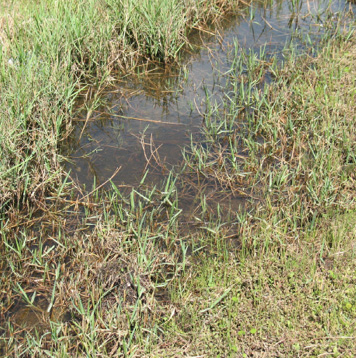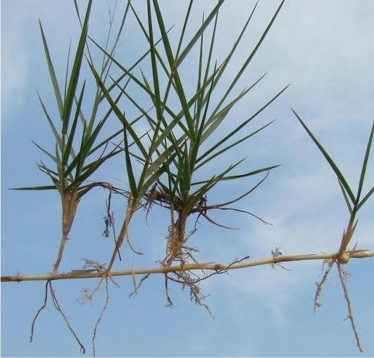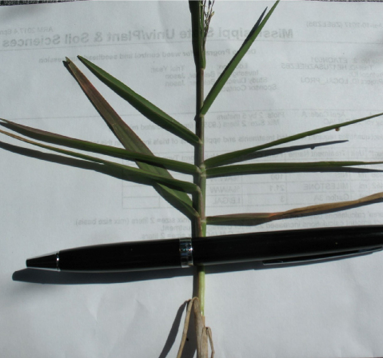Torpedograss



Torpedograss (Panicum repens L.) is a nonnative perennial grass native to Eurasia. It is considered one of the world’s worst weeds. When fully mature, torpedograss can grow up to 3 feet tall and form dense monotypic stands that displace native species and lead to a loss of diversity and overall ecological health (Figure 1). Torpedograss is a threat to wetlands and riparian zone areas because it eliminates desirable native plants. Once established in wetlands, it spreads onto adjacent terrestrial sites. Rhizomes produce new shoots and roots at every node to form dense stands aboveground (Figure 2). Torpedograss now occupies thousands of acres of marsh in Florida and occurs in 75 percent of Florida’s 67 counties.
Torpedograss is also a problem weed in turf and other areas in home landscapes. It has been considered for listing as a noxious weed in Mississippi by the Department of Agriculture and Commerce; however, it is not currently regulated. Torpedograss can also be a problem in orchards and many other crops grown with minimal soil disturbance. It does not provide adequate forage or habitat quality compared to the native plants it displaces. Once established, control can be extremely difficult.
Description
Vegetative
Torpedograss is a perennial, rhizomatous grass that can grow in excess of 2.5 feet tall. In wetlands, rhizomes may float or move with contaminated soil after flooding events. The sharp rhizome tips are the basis for the common name of torpedograss. It produces seeds, but viability is variable in North America, so the primary means of spread is vegetative (rhizome) reproduction. The aerial stems of torpedograss range from 1 to 3 feet tall and are glabrous (hairless). Upper leaf sheaths can be either glabrous or hairy; and leaf blades are stiff, linear, and flat to folded and range from 0.04 to 0.25 inches wide by 1 to 10 inches long (Figure 3). Blades are often grayish. Blades are glabrous to sparsely hairy below, but usually long-haired above, particularly near the ligule (a short, hair-like membrane).
Flowering
The inflorescence is a loose, open, or upright terminal panicle, 3 to 9 inches long. Inflorescences may be produced year-round. Spikelets are oval, 2 to 3 millimeters long, about 1 millimeter wide, and glabrous. The first husk around the grain is short, appearing as if it were shortened by cutting. The first husk is also loose and nearly encircles the base of the other spikelet bracts.
Dispersal
Similar to cogongrass [Imperata cylindrica (L.) Beauv.], the introduction of torpedograss to the United States was either an accident (as ballast water contamination) or deliberate (for forage uses sometime before 1876 when it was first collected in Mobile, Alabama). The extensive distribution of this plant is due in part to its movement in turfgrass and as a contaminate in containerized ornamentals. Rhizomes can also be moved by floodwater flowing through contaminated wetlands.
Habitat
Torpedograss is commonly found in tropical and subtropical climates with moist, sandy soils. It often grows near ditches, marshes, wetlands, estuaries, shores of freshwater lakes, ponds, and rivers as well as along the coastal shores of estuaries, bays, and oceans. Rhizomes can grow out from the shoreline and float in the water. Although torpedograss does well in wet soils, it is tolerant of drought when growing inland. It even outcompetes bermudagrass and other southern turfgrasses in lawns and sod production. It can be a problem weed in sugarcane and many other crops. Torpedograss prefers open areas with unrestricted sunlight, yet it can persist under partially shaded conditions.
Distribution
Torpedograss probably originated in the Old World. It is found from Southern Europe and Northern Africa to Asia and Australia. It also occurs in the New World tropics and subtropics. In the United States, it is found in California, Hawaii, and from Texas to Florida and North Carolina in the southeastern United States. Specifically, it occurs in all Gulf states.
Control Methods
Chemical
Chemical control is the preferred method for torpedograss control (Table 1). Glyphosate and imazapyr are labeled for managing torpedograss in aquatic sites. The chemicals can also be used on terrestrial sites; however, the product used must be labeled for use in the application site. This means you must use products with an aquatic label when managing torpedograss on an aquatic site. On terrestrial sites, such as bermudagrass turf, Drive can be used for selective torpedograss suppression, and Paramount can be applied to forages (Table 1).
Mechanical
Tillage practices have been used with little success. Tillage alone fragments the rhizomes and stimulates new growth. The best mechanical treatment strategies provide only temporary control of torpedograss. Therefore, landowners should use all precautionary measures feasible to prevent infestations. Closely inspect sod and containerized landscape material to make sure torpedograss rhizomes are not present in the growing media. Carefully inspect boating equipment, such as propellers and trailer rails, to make sure torpedograss vegetation is not transported between water bodies.
|
Herbicide |
Formulation |
Site |
Rate |
|---|---|---|---|
|
Glyphosate |
2 lb ae/gallon: Rodeo, Aquamaster, Glyfos, etc. |
Aquatic |
2% solution |
|
Glyphosate |
2 lb ae/gallon: Roundup, Glypro, Accord, etc. |
Terrestrial |
2% solution |
|
Imazapyr |
2 lb ae/gallon: Arsenal, Ecomazapyr, Habitat, Polaris, etc. |
Aquatic |
1% solution |
|
Imazapyr |
2 lb ae/gallon: Arsenal, Arsenal Powerline, Chopper, Polaris, etc. |
Terrestrial |
1% solution |
|
Quinclorac |
Drive 75DF, Paramount 75DF |
Terrestrial |
1 lb/acre |
References
Holm, L. G., Plucknett, D. L., Pancho, J. V., & Herberger, J. P. (1977). The world’s worst weeds: Distribution and biology. East-West Center/University Press of Hawaii.
Wallace, R. (2010). Torpedograss (Panicum repens) [Photograph]. Bugwood.org.
Publication 3193 (POD-04-24)
By John Byrd Jr., PhD, Extension/Research Professor, Plant and Soil Sciences, and Victor Maddox, PhD, Senior Research Associate, Plant and Soil Sciences.
The Mississippi State University Extension Service is working to ensure all web content is accessible to all users. If you need assistance accessing any of our content, please email the webteam or call 662-325-2262.



